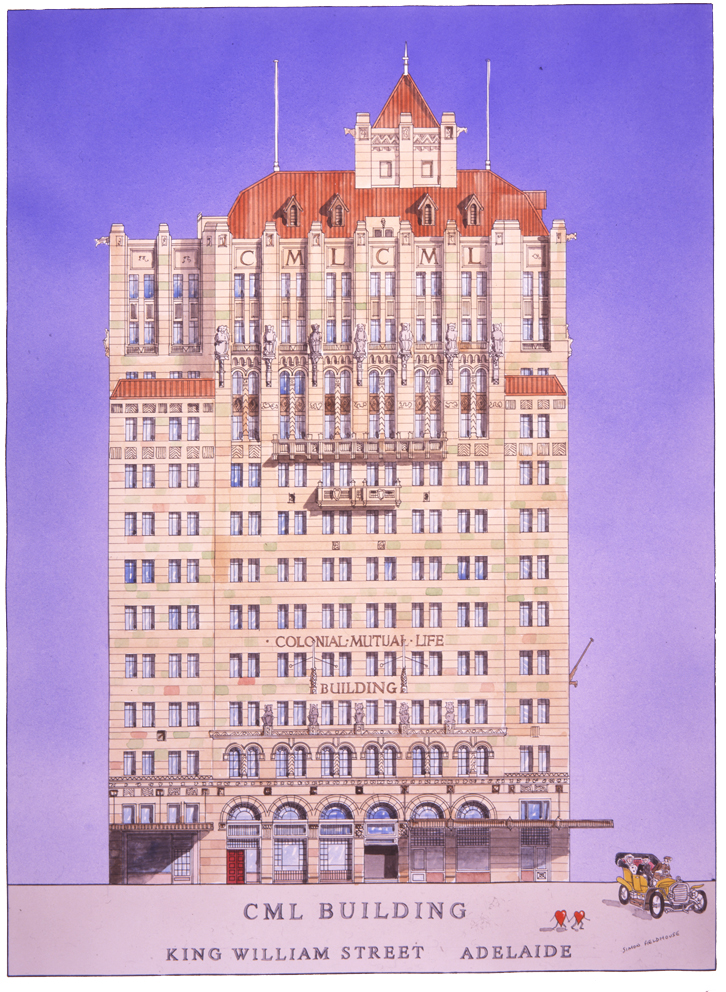
CML Building Adelaide - King William Street
Colonial Mutual Life (CML) Building on the corner of King William Street and Hindley Street in Adelaide, Australia, is a place steeped in history and architectural significance. At the heart of this intersection stands the Colonial Mutual Life (CML) Building, a majestic structure that has been an iconic landmark for over a century. This essay explores the rich history and architectural importance of this building and its enduring legacy in the heart of Adelaide.
The CML Building, constructed in 1938, is a prime example of Art Deco architecture, a style that reached its zenith in the 1920s and 1930s. With its sleek lines, geometric patterns, and ornate detailing, the building is a testament to the elegance and sophistication of this design movement. The choice of Art Deco for the CML Building was not only aesthetically pleasing but also symbolic of the optimism and innovation of the era. The building's exterior features a remarkable combination of materials, including stone, terracotta, and glass, which adds to its timeless charm.
Standing at a height of 51 meters, the CML Building has 11 stories and boasts a unique façade. Its central tower, which rises high above the intersection, is adorned with intricate motifs and decorative elements that reflect the Art Deco style. The contrasting colors of the stone and terracotta create a visually striking effect, making the building impossible to overlook. Moreover, the prominent position of the CML Building at the intersection of two major streets lends it a commanding presence in the city's skyline.
The CML Building's historical significance is also worth noting. It was constructed during a time when Adelaide was experiencing substantial growth, and it became a symbol of the city's progress and prosperity. The building originally housed the Colonial Mutual Life Assurance Society, which was one of Australia's leading insurance companies. Its prominence at the intersection of King William and Hindley Streets signified the company's strong financial position and commitment to its customers.
Over the years, the CML Building has seen various changes in ownership and usage. Today, it has been transformed into a boutique hotel, preserving its architectural heritage while offering a unique and luxurious accommodation experience for visitors. The building's rich history and striking architecture make it a popular choice for tourists and history enthusiasts who want to immerse themselves in Adelaide's past.
In conclusion, the corner of King William Street and Hindley Street, with the iconic Colonial Mutual Life (CML) Building at its center, represents a blend of history and architectural splendor. The building's Art Deco design, its historical significance, and its enduring presence in Adelaide's cityscape make it a cherished landmark. As it continues to evolve and adapt to modern uses, the CML Building stands as a testament to the enduring legacy of Adelaide's rich architectural and cultural heritage.
ual Life (CML) Building at the corner of King William Street and Hindley Street in Adelaide is an architectural masterpiece that epitomizes the elegance and sophistication of the Art Deco style.
One of the most distinctive features of the building's architecture is its verticality. Rising 51 meters into the sky, it stands tall amidst the city's surrounding structures. The building's height is accentuated by its stepped form, a characteristic of Art Deco design that creates a sense of grandeur. This tiered design is punctuated by a central tower, which is adorned with ornate detailing, including geometric patterns, decorative motifs, and a flagpole at its peak. The tower serves as a focal point and a symbol of the building's importance.
The use of contrasting materials is another architectural highlight of the CML Building. The façade combines pale stone and rich terracotta, which not only adds depth and texture but also creates a visual interplay of light and shadow. This contrast in materials is not only aesthetically pleasing but also serves to emphasize the building's horizontal and vertical lines, contributing to its overall Art Deco aesthetic.
The entrance to the CML Building is a work of art in itself. A grand, recessed entryway with a decorative archway leads visitors into the building. The archway features intricate reliefs and sculptures, adding a touch of opulence to the exterior. The use of decorative elements, such as stylized flora and fauna, geometric shapes, and symmetrical patterns, is a hallmark of Art Deco design and is prominently displayed throughout the building's architecture.
The windows of the CML Building are also a testament to its Art Deco influence. The windows are large and divided into multiple panes, often with curved or angular mullions and decorative detailing. These features not only allow for an abundance of natural light to enter the interior but also contribute to the building's overall aesthetic by creating interesting patterns and reflections.
In addition to its exterior, the interior of the CML Building continues to showcase the Art Deco style. The lobby is adorned with marble, terrazzo, and polished metals, and features decorative light fixtures and geometric patterns that are reminiscent of the era. This attention to detail in both the interior and exterior architecture makes the CML Building a remarkable example of Art Deco design.
In conclusion, the Colonial Mutual Life (CML) Building's architecture is a stunning representation of the Art Deco style. Its verticality, use of contrasting materials, decorative detailing, and iconic entrance make it an architectural gem in the heart of Adelaide. The building's design serves as a tribute to the era it was constructed in and continues to captivate admirers of architectural beauty and history to this day.